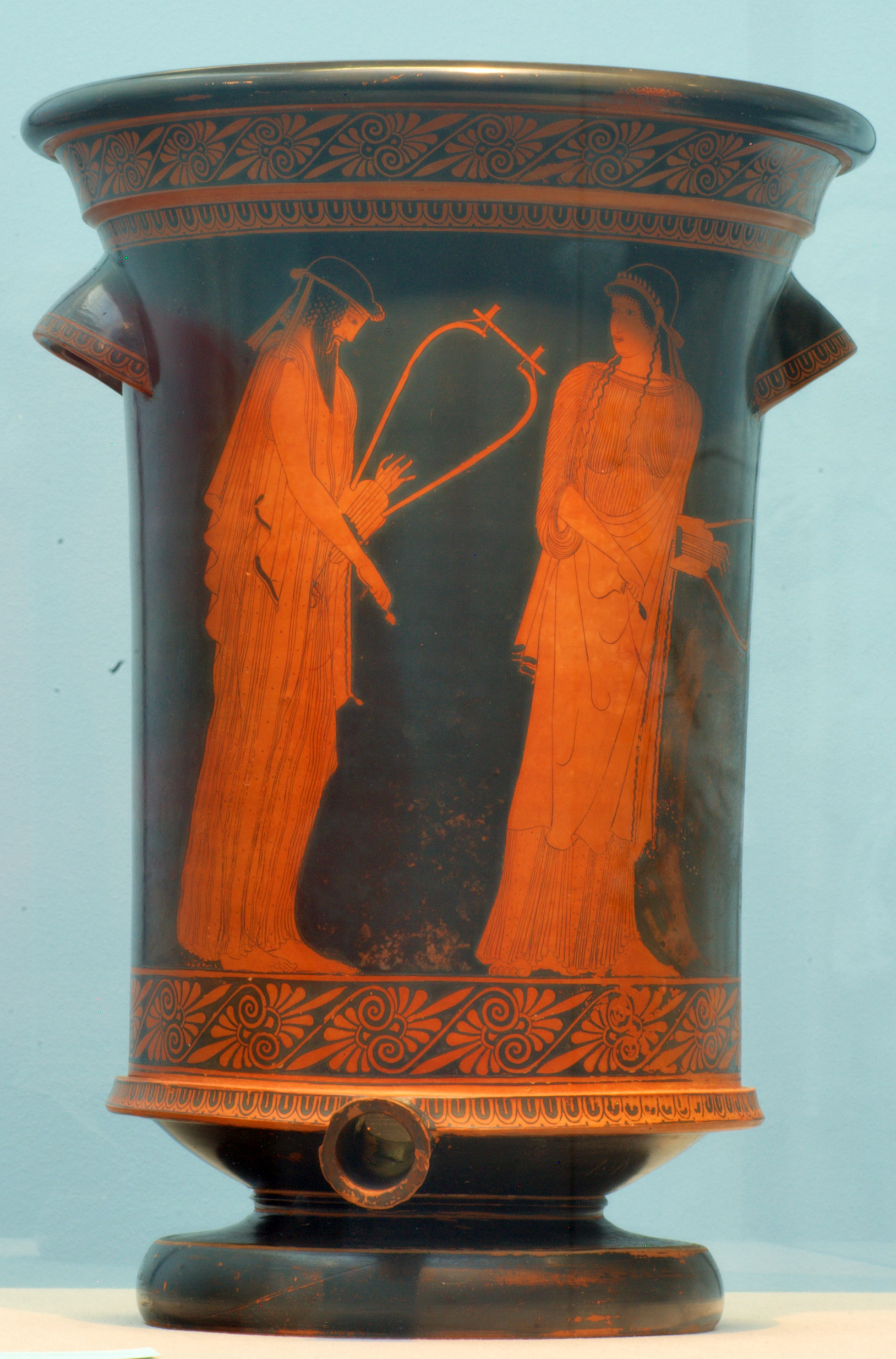|
Glyconic
Glyconic (from Glycon, a Greek lyric poet) is a form of meter in classical Greek and Latin poetry. The glyconic line is the most basic form of Aeolic verse, and it is often combined with others. The basic shape (often abbreviated as gl) is as follows: x x – u u – u – Here "x" indicates an anceps, "–" a longum, and "u" a brevis. "x x" is known as the Aeolic base, which can be a spondeus "– –", a trochee "– u", or an iamb "u –". The middle foot "– u u –" is a ''choriambus'', as a so-called choriambic nucleus is a defining element of Aeolic verse. As in all classical verse forms, the phenomenon of brevis in longo is observed, so although the last syllable can actually be short or long, it always "counts" as long. The acephalous ("headless") version (^gl), also known as the ''telesillean'' (Latin: ''telesilleus''), is: x – u u – u – Runs of glyconic lines are often ended by a pherecratean (a glyconic without the last brevis: x x – u u – ... [...More Info...] [...Related Items...] OR: [Wikipedia] [Google] [Baidu] |
Greek Lyric
Greek lyric is the body of lyric poetry written in dialects of Ancient Greek. It is primarily associated with the early 7th to the early 5th centuries BC, sometimes called the "Lyric Age of Greece", but continued to be written into the Hellenistic and Imperial periods. Background Lyric is one of three broad categories of poetry in classical antiquity, along with drama and epic, according to the scheme of the "natural forms of poetry" developed by Goethe in the early nineteenth century. (Drama is considered a form of poetry here because both tragedy and comedy were written in verse in ancient Greece.) Culturally, Greek lyric is the product of the political, social and intellectual milieu of the Greek ''polis'' ("city-state"). Much of Greek lyric is occasional poetry, composed for public or private performance by a soloist or chorus to mark particular occasions. The symposium ("drinking party") was one setting in which lyric poems were performed.Miller, ''Greek Lyric: An Antholog ... [...More Info...] [...Related Items...] OR: [Wikipedia] [Google] [Baidu] |
Iamb (poetry)
An iamb () or iambus is a metrical foot used in various types of poetry. Originally the term referred to one of the feet of the quantitative meter of classical Greek prosody: a short syllable followed by a long syllable (as in () "beautiful (f.)"). This terminology was adopted in the description of accentual-syllabic verse in English, where it refers to a foot comprising an unstressed syllable followed by a stressed syllable (as in ''abóve''). Thus a Latin word like , because of its short-long rhythm, is considered by Latin scholars to be an iamb, but because it has a stress on the first syllable, in modern linguistics it is considered to be a trochee. Etymology R. S. P. Beekes has suggested that the grc, ἴαμβος ''iambos'' has a Pre-Greek origin. An old hypothesis is that the word is borrowed from Phrygian or Pelasgian, and literally means "Einschritt", i. e., "one-step", compare ''dithyramb'' and ''thriambus'', but H. S. Versnel rejects this etymology and sugg ... [...More Info...] [...Related Items...] OR: [Wikipedia] [Google] [Baidu] |
Anacreon
Anacreon (; grc-gre, Ἀνακρέων ὁ Τήϊος; BC) was a Greek lyric poet, notable for his drinking songs and erotic poems. Later Greeks included him in the canonical list of Nine Lyric Poets. Anacreon wrote all of his poetry in the ancient Ionic dialect. Like all early lyric poetry, it was composed to be sung or recited to the accompaniment of music, usually the lyre. Anacreon's poetry touched on universal themes of love, infatuation, disappointment, revelry, parties, festivals and the observations of everyday people and life. Life Anacreon was born around 582 BC at Teos, an Ionian city on the coast of Asia Minor. The name and identity of his father is a matter of dispute, with different authorities naming four possibilities: Scythianus, Eumelus, Parthenius, or Aristocritus. It is likely that Anacreon fled into exile with most of his fellow-townsmen who sailed to Thrace when their homeland was attacked by the Persians. There they founded a colony at Abdera, r ... [...More Info...] [...Related Items...] OR: [Wikipedia] [Google] [Baidu] |
Pherecratean
Aeolic verse is a classification of Ancient Greek lyric poetry referring to the distinct verse forms characteristic of the two great poets of Archaic Lesbos, Sappho and Alcaeus, who composed in their native Aeolic dialect. These verse forms were taken up and developed by later Greek and Roman poets and some modern European poets. General description Essential features and origin Sappho and Alcaeus' verses differ from most other Greek lyric poetry in their metrical construction: * Verses consist of a fixed number of syllables (thus, for example, no resolution Resolution(s) may refer to: Common meanings * Resolution (debate), the statement which is debated in policy debate * Resolution (law), a written motion adopted by a deliberative body * New Year's resolution, a commitment that an individual mak ..., contraction, or biceps (prosody), biceps elements). * Consecutive anceps syllables may occur, especially at the beginning of the verse (where two initial anceps syllabl ... [...More Info...] [...Related Items...] OR: [Wikipedia] [Google] [Baidu] |

